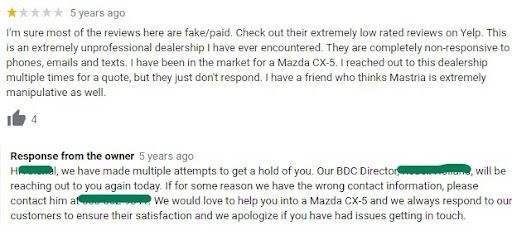Life on the Internet can be stressful – even more for anyone who's selling a product or service. Negative comments and reactions on your social media are standard and almost expected whether you're a brand or an individual. Receiving these comments is inevitable, but the important thing is how you handle them. Poor handling can hurt you and your brand and turn customers away.
According to ReviewTrackers, 94% of consumers say that a bad review has convinced them to avoid a business. This is why it’s essential to create a clear and concise policy for what to do when you encounter negativity on your social media so you can tackle it before it becomes a problem for your business.
1. Always address negative comments about you or your brand
Should you address every comment you receive? We think so. Maintaining public relations is essential for personal and business brand building; part of that is customer engagement in both positive and negative circumstances.
Noting the comments you get — positive, negative, or neutral — can help you understand followers’ sentiments about your brand and your content which, in turn, enables you to connect better with them.
Rosie Hall, a PR & Communications Manager at Hable, agrees with this approach, saying, “My policy for dealing with negative comments on social media has always been to address it quickly, be apologetic, and then try to take it off the public-facing areas to discuss it privately. I think that way, your audience knows that you’re dealing with any issues, but the detail remains private. Never deleting negative comments is also a bit of a golden rule for me – it can get people even angrier, and it looks like your brand has got something to hide. A big no!”
Royal Bank of Canada’s Twitter response team took this approach – instead of getting defensive, they approached with empathy and an offer to help.

However, the exception to this rule will have to be your or your social media manager’s mental health, which should take priority over anything else. From negative but fair feedback from customers to outright unfair or incendiary comments from trolls, it can be difficult to face attacks of any kind on social media.
It’s natural to deal with negativity. If a rude comment affects you, speak to someone on your team or your circle of friends and family. No matter how personal a comment might seem, the commenter doesn’t know you. Be secure in your value, focus on positives, and let the negatives fade.
2. Determine how to respond to different types of negative comments
Your social media strategy should include a set of standards for responding to incoming notifications and messages. Your team should be clear on how quickly they need to reply and provide some templated on-brand messaging that addresses frequently asked questions.
Stephanie Gutierrez, a Senior Social Media Strategist at Online Optimism – a marketing agency – shares the system and steps that the agency has developed to address communications issues – especially when it comes to negativity. Stephanie says, “At our agency, we produce a Communications Guide for each client at the start of our partnership. This allows us to plan for any messages or comments we anticipate receiving on social media, good or bad, so we’re ready to respond in a timely manner.”
Based on Stephanie’s guidelines, here are some steps to creating standards for your social media communications.
- Identify which questions come up from your customers the most, as well as the positive and negative feedback they tend to give. Stephanie recommends asking your salesperson/team if you have one. You can also look through your social media profiles to see what questions and comments you’ve received in the past.
- Plan out a few responses to negative situations that you anticipate so several options are available. For example, if someone can’t get a hold of your customer service or if someone’s order was wrong, having a few answers on hand prevents users from feeling like you’re copying and pasting the same message for everyone.
- Plan to update these responses from time to time, so they remain relevant and don’t feel stale. If a question or comment comes up that wasn’t in your guide, add it with the approved response so you are prepared for the next time it comes up.
- Your responses should address the individual in a personalized way by calling them by their name. Acknowledge the issue they are facing and reassure them that you want to set things right if they had a negative experience. Personalized messages help customers feel heard. Nike’s customer response team took personalization to the next level, offering to help the customer find the exact item they were looking for.

In addition to Stephanie’s advice, here are some other practices to include in your Communications Guide:
- Frequently reiterate your policies on harassment on your social media account
- Use the BIFF (Brief, Informative, Friendly, and Firm) framework to respond to comments
- Ignore the comments and don’t respond if you don’t absolutely need to
- Consider muting or blocking them (after determining that the person in question is actually a troll)
- If it goes too far, report the post.
By having your policy in mind, you’ll be prepared should a situation arise. And in an added layer to creating a communications policy, make sure every employee is aware of how to handle negativity on your public-facing channels, even if they don’t normally interact with customers. This way, everyone in your organization knows how to address any situations that may arise.
3. Respond on time
One of the critical difficulties in responding to negative comments on social media is time, as Rafal Mlodzki, CEO of Passport Photo Online, points out. People want a quick response when things go wrong and social media makes it so that customers worldwide (and in different timezones) are constantly engaging with your brand. So, a lack of response might signal that you don’t care about your customers’ opinions.
Here at Buffer, we have lots of experience responding to messages quickly. Team members in both Marketing and Customer Advocacy have access to our social accounts so we can respond to users quickly. A great example is this tweet that was sent out at 4:40 am (GMT +1) and the response from our team 4 minutes later.
Hey Ashish! I'm sorry to say that we are unable to connect and directly publish to Instagram and Facebook Personal Profiles. You can read more on this here https://t.co/AJgCtWQQOC. -James
— Buffer (@buffer) July 11, 2022
However, while we have a large team in place for customer engagement, that isn’t possible for every business owner. If you can’t afford a large team dedicated to customer engagement, consider sharing that on your profile (for example, pinning a post with your response policy to the top of your Instagram or Twitter), and remember to give your customers a time frame of when you’ll be getting back to them
4. Approach negative comments with facts and not emotions
It’s crucial to respond factually when faced with a negative comment, whether it’s admitting when you’re wrong, offering a solution, or countering misinformation.
If you or your brand is wrong, apologize sincerely and provide a solution for the aggrieved customer. However, if someone is only posting to get a reaction out of you or your audience, then Logan Mallory, VP at Motivosity which creates employee engagement software, recommends that you do not engage.
As Logan shares, “There’s a difference between someone voicing concern and someone who’s just trying to be an instigator. You can and should reply to negative comments where someone is directly expressing concern, but when it comes to comments that are simply inflammatory remarks, those are best left alone. A reply won’t do any good, and can simply cause the person posting those comments to post even more.”
However, this option won’t work for every scenario – while ignoring negative comments might seem like the right move as you’re not feeding the fire, it can also seem suspicious to some of your followers.
If you have to address potentially misleading information, share fact-based sources that refute the wrong information. Don’t respond directly to the troll – your response shouldn’t be for them. Instead, leave a comment that clears up any confusion that may arise. While this isn’t from social media, it’s a great example of how to put out a fire with facts. This Mazda dealership defended itself by stating the steps they took to solve the customer’s complaint, effectively shutting down the problem.

Ultimately, you must figure out what approach – ignoring vs. responding with facts – is best case-by-case.
5. Always report harassment
There’s a fine line between criticism and outright harassment — if someone makes you or your followers uncomfortable or even threatens you on social media, don’t hesitate to report them.
Check out the policies that Facebook, Twitter, Instagram, and other major sites have when it comes to filing complaints about abusive behavior. Also, consider blocking accounts that harass you or your followers and highlighting them for your legal team and community to be aware of.
Consider creating a “rules of conduct” post and pinning it on your profile. Then, if someone behaves inappropriately, you’ll have a clear justification for booting them.
Focus on cultivating positivity between you and your community
Social media is incredible for its ability to bring the world together. But unfortunately, that does open us up to a world of negativity. It’s just something that brands have to deal with, especially as they grow and garner more attention.
That’s why it’s important to remain positive when dealing with social media trolls and also encourage healthy interactions with the supportive part of your community. David Bitton, CMO at DoorLoop a property management software company, recommends that you outright dismiss exchanges that could potentially induce conflict before they become heated if the conversation adds no value to achieving your business goals on social media.
Your goal when managing your community should be to foster a supportive environment where people feel safe to have honest dialogue, listen, ask questions, and express their points respectfully.
Want to keep an eye on everything happening in your comments and mentions across all your social media accounts? Try out Engage by Buffer.
Try Buffer for free
190,000+ creators, small businesses, and marketers use Buffer to grow their audiences every month.




